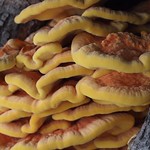Sulphur Fungus (Laetiporus sulphureus)
Walking north into downtown Van Nuys I spotted this amazing example of a sulphur fungus growing in the crook of a tree. It was so brightly colored it almost look artificial. Such a fungus doesn’t bode well for the health of the tree as it is a sign of internal decay, but it is still a striking bit of nature right here in the city.
Click for larger images
Laetiporus sulphureus is a species of bracket fungus (fungus that grows on trees) found in Europe and North America. Its common names are crab of the woods, sulphur polypore, sulphur shelf, and chicken of the woods. Its fruit bodies grow as striking golden-yellow shelf-like structures on tree trunks and branches. Like other bracket fungi, they may last many years and fade to pale grey or brown. The undersurface of the fruit body is made up of tubelike pores rather than gills.
Laetiporus sulphureus is a saprophyte and causes brown cubical rot in the heartwood of trees on which it grows. Unlike many bracket fungi, it is ediblewhen young.
The cap is small and knob-shaped, overlapping in an irregular pattern. Wide, shaped like a fan and attached direct to the trunk of a tree, it has a shelf-like appearance and is sulphur-yellow to bright orange in colour and has a suedelike texture. When it is old the cap fades to tan or white. The shelves often grow in overlapping clumps, and each one may be anywhere from 5 to 60 cm (2 to 24 in) in diameter and 4 cm (1.4 in) thick.[3] The fertile surface is sulphur-yellow with small pores or tubes and has a white spore print.[4] — Wikipedia.org
- Sulphur Fungus (Laetiporus sulphureus) on Wikipedia
- Sulphur Fungus (Laetiporus sulphureus) from Iowa State University
- Sulphur Fungus (Laetiporus sulphureus) from Missouri Department of Conservation
Previously in the Interesting Plant series:
- Bauhinia
- Blue Flax (Linum lewisii)
- Chestnut (Castenea)
- Camellia japonica ‘Anemoniflora’
- Zaluzianskya villosa “Southern Lilac Drumsticks”
- Prickly Pear Cactus (Opuntia)
- Campanula
- Rudbeckia
- Caladium bicolor ‘White Queen’
- Fuchsia
- Palo Verde Tree (Parkinsonia florida)
- Espalier Fruit Trees
- California Poppy (Eschscholzia californica)
- Hydrangea ‘Zorro’
- Harlequin flower (Sparaxis tricolor)
- Erythronium
- Sempervivum
- Primula auricula
- Feathery Cassia (Senna auricula)
- Red Stick Dogwood (Cornus alba ‘Sibirica’)
- Japanese Maple (Acer palmatum)
- Kousa Dogwood (Cornus kousa)
- Giant Chalk Dudleya (Dudleya brittonii)
- Sunrose (Helianthemum nummularium)
- Australian/New Zealand Tea Tree (Leptospermum scoparium)
- Brugmansia Sanguinea
- Calico Monkeyflower (Mimulus pictus)
- Colocasia Esculenta
- Acer palmatum ‘Sango-kaku’ (Coral Bark Japanese Maple)
- Linderniaceae (formerly Torenia) Kuaui Deep Blue
- Passiflora (Passion flower)
- Firewheel Tree (Stenocarpus sinuatus)
- Anemone
- Allium Cowanii
- Symphyotrichum oblongifolius (Purple Aster)
- Hemerocallis ‘Derrick Cane’ (Daylily)
- Agastache ‘Aztec Rose’
- Rudbeckia hirta Moreno
- Kalanchoe Tomentosa
- Albuca namaquensis
- Hosta ‘Remember Me’
- Dahlia ‘Clair de Lune’
- Lovely silver-tinged fern on campus of Oberlin College, Ohio
- Tricolor Beech (Fagus sylvatica Purpurea Tricolor)
- Climbing Hydrangea (Hydrangea anomala petiolaris)
- Eremurus ‘Lemon Meringue’
- Lupine “Sunrise” (Lupinus hartwegii)
- Chinese Fringe Flower (Loropetalum chinense)
- Streptocarpus ‘Harlequin Blue’
- Nigella damascena (love-in-a-mist, ragged lady)
- Epiphyllum (Orchid Cactus)
- Sempervivum ‘Westerlin’
- Gladiolus ‘Kings Lynn’
- Hosta sieboldiana ‘Dorothy Benedict’
- Begonia “Escargot”
- Asparagus Pea (Psophocarpus tetragonolobus)
- Rosa banksiae (Lady Banks’ Rose)
- Primula ‘Victoriana Silver Laced Black’
- Oxalis versicolor
- Poached Egg Plant (Limnanthes douglasii)
- Parisian Carrots
- Fritillaria imperialis Rubra Maxima
- Clematis “Fascination”
- Swiss Chard “Bright Lights”
- Georgia Rattlesnake Melon
- Dianthus Barbathus “Green Ball” or “Green Trick”
- Coleus “Religious Radish”
- Black Forest Calla Lily
- Black Bamboo
Interesting Plant is a series from A Gardener’s Notebook blog and podcast that highlights the most interesting plants I find in my Internet and real-world travels — Douglas







